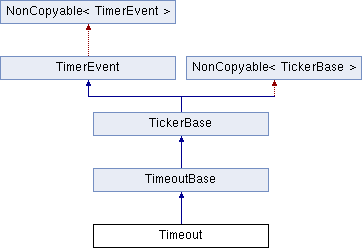Timeout
 Timeout class hierarchy
Timeout class hierarchy
Use the Timeout interface to set up an interrupt to call a function after a specified delay.
You can create any number of Timeout objects, allowing multiple outstanding interrupts at the same time.
Warnings and notes
-
No blocking code in ISR: avoid any call to wait, infinite while loop or blocking calls in general.
-
No printf, malloc or new in ISR: Avoid any call to bulky library functions. In particular, certain library functions (such as printf, malloc and new) are not re-entrant, and their behavior could be corrupted when called from an ISR.
-
While a Timeout is running, deep sleep is blocked to maintain accurate timing. If you don't need microsecond precision, consider using the LowPowerTimeout class instead because this does not block deep sleep mode.
Timeout class reference
| Public Types | |
| using | clock = HighResClock |
| Clock to use with attach_absolute, guaranteeing running only while attached or manually locked. More... | |
| Public Member Functions | |
| HighResClock::time_point | scheduled_time () const |
| template<class F > | |
| void | attach_absolute (F &&func, HighResClock::time_point abs_time) |
| Attach a function to be called by the Timeout, specifying the absolute time. More... | |
| std::chrono::microseconds | remaining_time () const |
| Return time remaining until callback. More... | |
| template<typename F > | |
| MBED_FORCEINLINE void | attach (F &&func, float t) |
| Attach a function to be called by the Ticker, specifying the interval in seconds. More... | |
| void | attach (Callback< void()> func, std::chrono::microseconds t) |
| Attach a function to be called by the Ticker, specifying the interval in microseconds. More... | |
| void | attach_us (Callback< void()> func, us_timestamp_t t) |
| Attach a function to be called by the Ticker, specifying the interval in microseconds. More... | |
| void | detach () |
| Detach the function. More... | |
Timeout hello, world
Set up a Timeout to invert an LED after a given timeout:
/*
* Copyright (c) 2006-2020 Arm Limited and affiliates.
* SPDX-License-Identifier: Apache-2.0
*/
#include "mbed.h"
Timeout flipper;
DigitalOut led1(LED1);
DigitalOut led2(LED2);
void flip()
{
led2 = !led2;
}
int main()
{
led2 = 1;
flipper.attach(&flip, 2.0); // setup flipper to call flip after 2 seconds
// spin in a main loop. flipper will interrupt it to call flip
while (1) {
led1 = !led1;
ThisThread::sleep_for(200);
}
}
Timeout example
Try this example to attach a member function:
/*
* Copyright (c) 2006-2020 Arm Limited and affiliates.
* SPDX-License-Identifier: Apache-2.0
*/
#include "mbed.h"
// A class for flip()-ing a DigitalOut
class Flipper {
public:
Flipper(PinName pin) : _pin(pin)
{
_pin = 0;
}
void flip()
{
_pin = !_pin;
}
private:
DigitalOut _pin;
};
DigitalOut led1(LED1);
Flipper f(LED2);
Timeout t;
int main()
{
// the address of the object, member function, and interval
t.attach(callback(&f, &Flipper::flip), 2.0);
// spin in a main loop. flipper will interrupt it to call flip
while (1) {
led1 = !led1;
ThisThread::sleep_for(200);
}
}